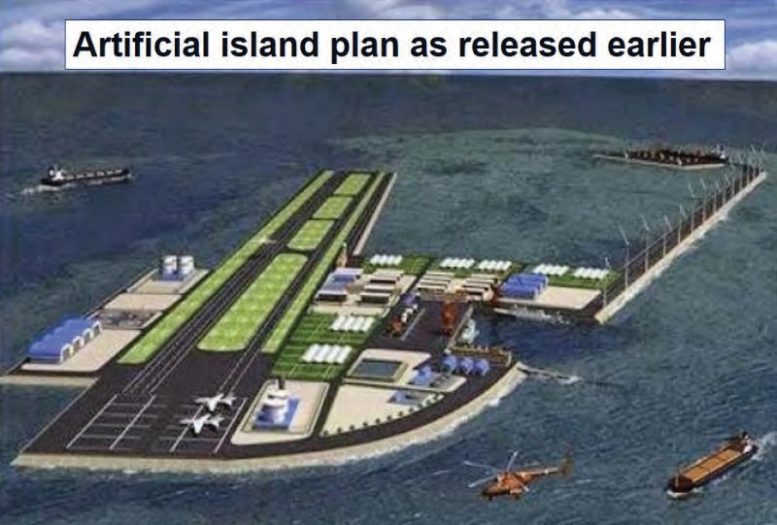My involvement in the Spratlys, South China Sea and West Philippine Sea issue goes back a long way. As a junior officer, fresh from the Naval Academy, I was part of a secret mission sometime in 1971. I transported troops,weapons, equipment and supplies to the islands we occupied in Freedomland, now called the Kalayaan Island Group.

Spratlys 1971
In 1994 when China built a structure in Mischief Reef, well within the Philippine Exclusive Economic Zone, I, in my capacity then as a member of the Philippine Congress, raised the alarm bells in spite of the assurance of China that it was just for the temporary shelter of their fishermen.
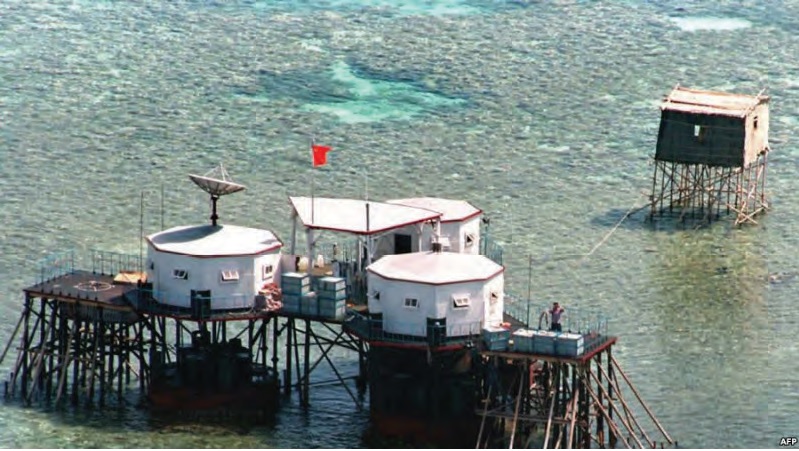
Chinese Structure in Mischief Reef, 1994
In 1999, as a member of the Philippine Congress, I delivered a privilege speech and warned that China’s next objective was Scarborough Shoal.
Just as I feared, the temporary structure was transformed into a permanent structure in 1999 as shown by this photo.
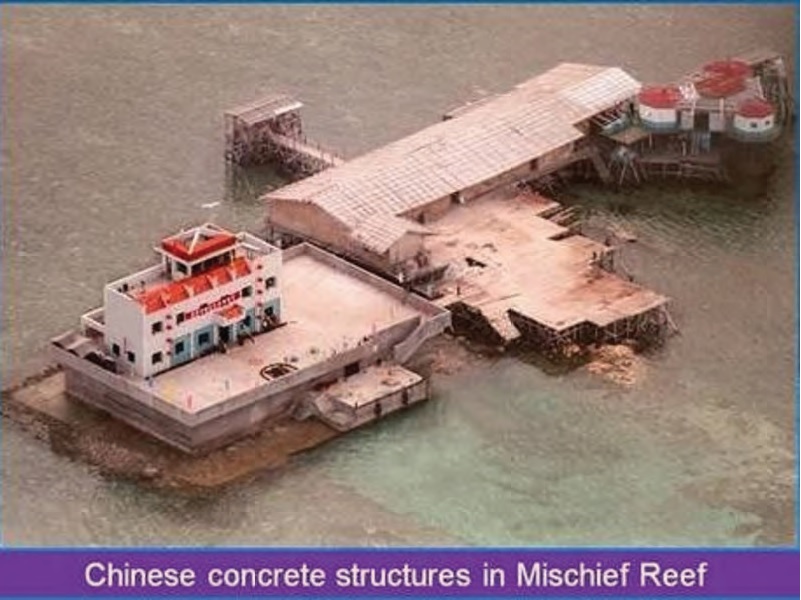
“Scarborough Shoal is part of China’s military projection at the South China Sea.”
In Scarborough Shoal, China has found a perfect forward fortress at the east to back up its slow but nonstop political and naval march towards the north, where Korea, Japan, Taiwan, are among others. China has unleashed a blob at the South China Sea, floating eastward, growing slowly, menacingly, nearly unopposed, devouring every speck, every shoal and reef along the way.
“Chinese military contingents are already positioned in various reefs, islets, and rocks of the South China Sea Region, particularly in the Spratlys and the Paracels. Scarborough Shoal is just one more step forward in their bid to secure full control of the world’s second busiest international sea lane.
”In 2012, China occupied Scarborough Shoal, well within our Exclusive Economic Zone. Thus, there is now a
dagger aimed at the country’s vital economic and military installations: Subic, Clark, Metro Manila, primary airports and sea ports, power plants, Calabarzon and our Army, Navy and Air Force bases.
It is my view that the security complexion changed significantly since January this year when we had a meeting
here in Tokyo.
Last January, taking note of China’s massive reclamation activities in the South China Sea, they are originally presented as follows: Cuarteron Reef, Fiery Cross Reef, Johnson South Reef, Gaven Reef, and Johnson North Reef. Added to the above are Subi Reef which is very close to our PagAsa Island and Mischief Reef.
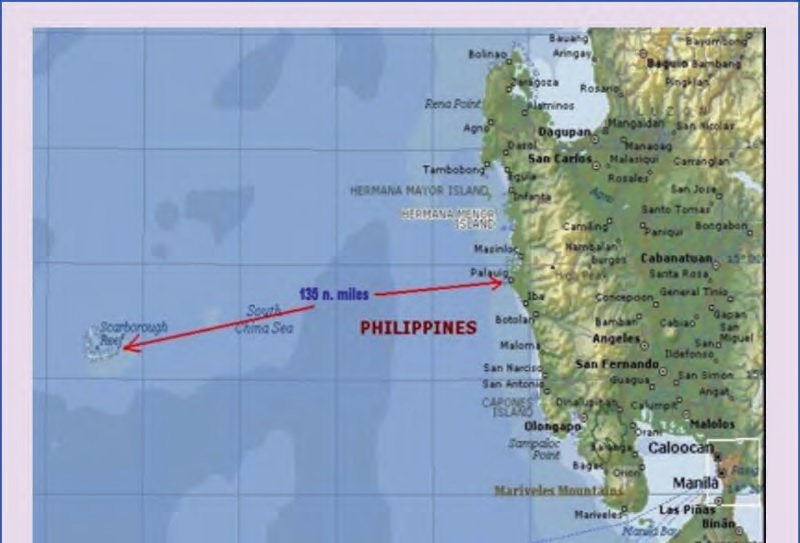
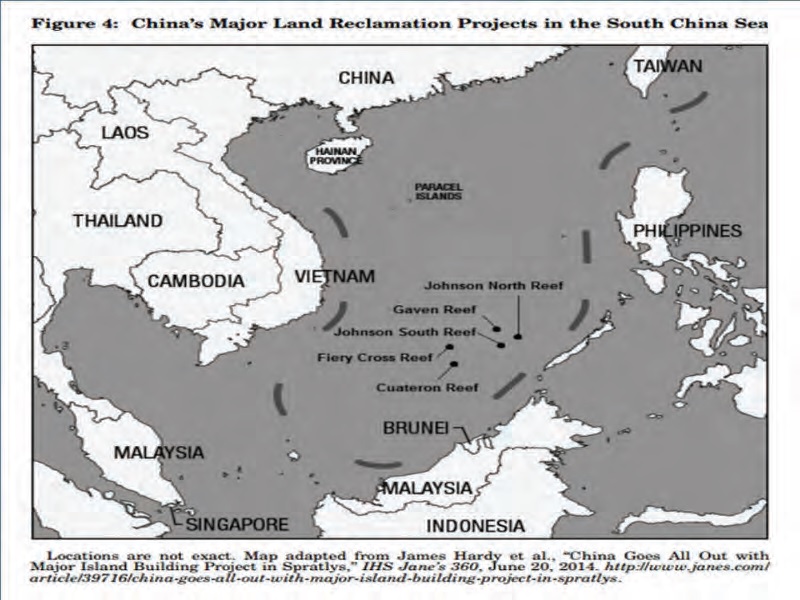
In last January’s Symposium of the Japan Institute for International Policy Studies, one of the authoritative speakers, retired Adm.Yoji Koda, theorized that China is developing a Strategic Triangle in the South China Sea.

When we got hold of China’s Grand Design for their reclamation projects, it appeared incredible at first. Many thought the plan was too massive as shown by the perspective Artificial Island plan.
The plan has now taken shape and it is very alarming as shown by the actual vs. the plan in Fiery Cross Reef.
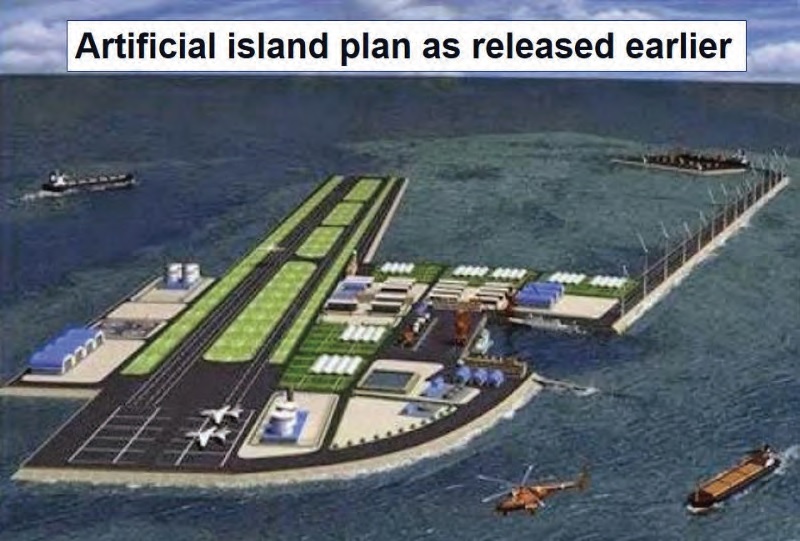
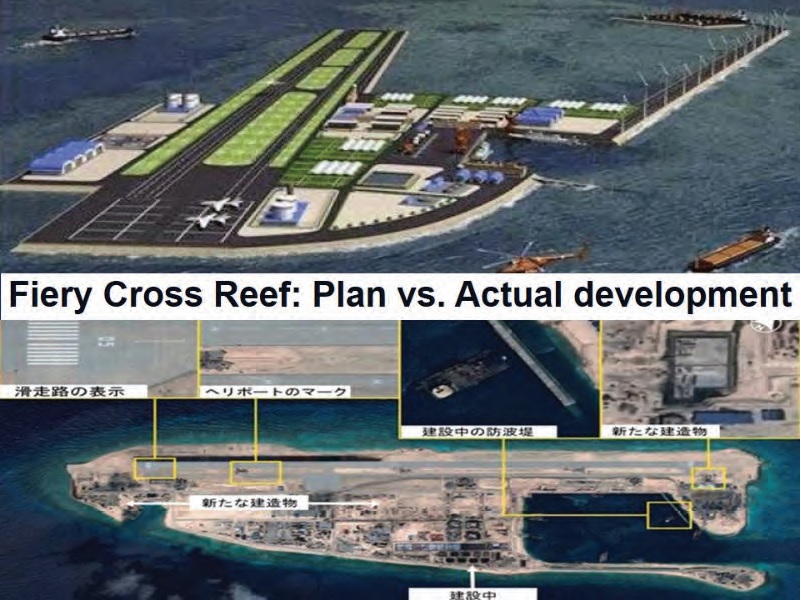
A fully militarized artificial island in Mischief Reef will be a threat not only to the Philippines but the entire region as shown in the actual vs. plan map.
A Chinese fighter plane like the J-11 with a 1,000 radius operating out of an airbase in Mischief Reef can cover the
entire Philippines, all of Borneo and almost all of Vietnam.
In May, the security situation and complexion changed very significantly with a series of statements from top security officials of the United States. This was obviously prompted by the radically changing facts on the ground.
By late May, the US Defense Secretary issued the following statement on the occasion of the Change of Command of the Commander, Pacific Command in Honolulu: “We will remain the principal security power in the Asia- Pacific for decades to come.”

“There should be no mistake: the United States will fly, sail, and operate wherever international law allows, as we do all around the world,” Carter said at the U.S. military’s joint base at Pearl Harbor.
This was followed by the deployment of a P-8 Surveillance Plane over one of the artificial island accompanied by a CNN reporter. It was designed as a high profile message beamed the world.
Next, the Pentagon released in August this year their “Asia-Pacific Maritime Security Strategy Paper which as announced as follows:
“The document rejects Chinese sovereignty claims over disputed islands in the South China Sea, asserts that the United States will enhance its “force posture and persistent presence” in the region while “building the capacity” of allies and partners, and explicitly supports India’s “Act East” policy as a “strategic convergence” with the U.S. re-balance, embracing India as a “net provider of security in the Indian Ocean region and beyond.

”China celebrated the 70th anniversary of the end of the Second World War with a massive “parade of tanks, missiles and troops that displayed their growing military might.”
President Xi Jinping who presided over the parade ironically delivered a speech that day stating: “China will remain committed to peaceful development. We Chinese love peace. Now matter how much stronger it may become, China will never seek hegemony or expansion. Or will never inflict its past suffering on any other nation.”
According to STRATFOR, “The most notable weapons on display were the cruise and ballistic missiles. Tanks, self-propelled artillery and other armored vehicles also rolled by while large numbers of fighter aircraft (including the J-15 carrier based fighter) and helicopters flew overhead. Missiles that were previously closely guarded were also shown, such as the DF-16 short-range ballistic missile, and the DF-21D anti-ship ballistic missile, the DF-10A land- attack cruise missile, and the DF-26 intermediate-range ballistic missile.”
Japan passed a new security legislation that will allow Japan’s military to mobilize overseas when these three conditions are met:
- When Japan is attacked, or when a close ally is attacked, and the result threatens Japan’s survival and poses a clear danger to people.
- When there is no other appropriate means available to repel the attack and ensure Japan’s survival and protect its people. Use of force is restricted to a necessary minimum.
The exchange of strong statements and warnings continued. Days before the State visit of President Xi Jinping in Washington D.C., the Commander of US Pacific Command told the US Senate that “America should challenge China’s claim to territory in the South China Sea by patrolling close to artificial islands built by Beijing.”
China responded by stating “It would not stand for violations of its territorial waters in the name of freedom of navigation,” as the United States considers sailing warships close to China’s artificial islands in the South China Sea.
And finally the US patrol happened. On 27 October, 2015 Lassen navigated within 12 nautical miles of Subi Reef, one of seven artificial islands built up by China in the South China Sea.
China’s response as reported by international news: “China’s Foreign Ministry reacted angrily after a U.S. Navy ship passed within 12 nautical miles of disputed islands in the South China Sea late Monday in an apparent challenge to Beijing’s territorial claims in the region.”
“ The ministry said that authorities monitored and warned the guided missile destroyer USS Lassen as it moved inside what China claims as a 12-mile territorial limit around Subi Reef in the Spratly Islands archipelago, a disputed group of hundreds of reefs, islets, atolls and islands in the South China Sea that is also claimed by the Philippines.”
American ambassador to protest the Lassen’s sail through. Chinese netizens sounded dismayed. A sample comment: “They walked around our house, and all we could do was shout through the window,” one netizen bemoaned on Sina Weibo, China’s version of Twitter.
“It is a joke that we can only try to stop the US from harming Chinese sovereignty in the South China Sea only with a warning,” another said.
Meantime in the legal front, the Philippines won the first round of its case in the Permanent Court of Arbitration in the Hague. The arbitral tribunal concluded that it had jurisdiction over seven Philippine assertions:
Out of the Philippines’ 15 submissions (or issues for arbitration), the tribunal concluded that it had jurisdiction over seven assertions:
- Panganiban Reef (Mischief Reef), Ayungin Shoal (Second Thomas Shoal) and Zamora Reef (Subi Reef) “are low-tide elevations that do not generate entitlement to a territorial sea, EEZ or continental shelf” and that they cannot be appropriated by occupation.
- Gavin Reef (Gaven Reef) and McKennan Reef (Hughes Reef) are low-tide elevations that do not generate entitlement to a territorial sea, EEZ or continental shelf, but their low-water line may be used to determine the baseline from which the breadth of the territorial sea of Binago Island (Namyit Island) and Rurok Island (Sin Cowe Island), respectively, is measured.
- Panatag Shoal (international name: Scarborough Shoal) generates no entitlement to an exclusive economic zone (EEZ) or continental shelf.
- Mabini Reef (Johnson South Reef), Calderon Reef (Cuarteron Reef) and Kagitingan Reef (Fiery Cross Reef) generate no entitlement to an EEZ or continental shelf.
- China has unlawfully prevented Philippine fishermen from pursuing their livelihoods by interfering with traditional fishing activities at Panatag Shoal.
- China has violated its obligations under Unclos to protect and preserve the marine environment at Panatag Shoal and Ayungin Shoal.
- China has breached its obligations under Unclos by operating its law enforcement vessels in a dangerous manner causing serious risk of collision to Philippine vessels navigating in the vicinity of Panatag Shoal.
Seven other submissions “will need to be considered in conjunction with the merits,” the tribunal said.
These include the Philippine assertions that:
A. China’s maritime entitlements may not extend beyond what UNCLOS states.
B. China’s nine-dash-line claim in the South China Sea should be declared invalid.
C. China has “unlawfully aggravated and extended the dispute” through preventing Philippine navigation, rotation and resupply of its troops on Ayungin Shoal.
D. China’s occupation and construction activities on Panganiban Reef violate UNCLOS.
E. Panganiban Reef and Ayungin Shoal are parts of the EEZ and continental shelf of the Philippines.
F. China has interfered with the Philippines’ exercise of its sovereign rights to resources within its EEZ.
G. China “unlawfully failed to prevent its nationals and vessels” from exploiting resources within Philippine territory.
However, China reiterated it won’t accept Hague sovereignty arbitration with this blunt statement: “China has repeatedly expounded its position of not accepting or getting involved in these proceedings initiated unilaterally by the Philippines.”
The recalcitrant position of China faces stiff international opposition.
Singapore Law Watch reacted by stating: “Instead of hurling political rhetoric at the tribunal, it would be more productive if China attempts to make a legal rebuttal and argue why it feels that Article 288 does not apply in this case. Otherwise, what the world will see is a country that claims to defend international law while flouting it when a ruling goes against its interests. That’s a sore loser – not an upholder of law.”
“The United States noted that the final decision by the international tribunal in The Hague – not expected until next year – would be legally binding on both the Philippines and China, which have both ratified the UN Convention on the Law of the Sea.
“Top US diplomat for East Asia, Daniel Russel, said that when the tribunal issues its final decision, there would be an international expectation that China would not flout its obligations under the convention.”
I note three developments that are of great concern to the Philippines and could have a grave impact on the region:
- US FREEDOM OF NAVIGATION PATROLS: The first one is the announced second Freedom of Navigation patrol to be conducted by the United Sates Navy. Personally, I welcome this as necessary in checking the aggressiveness of China but the region must brace itself for the response of China to the second and succeeding patrols. What forces will the US deploy the next time? How would China respond?
- ARBITRAL TRIBUNAL CASE AGAINST CHINA: The Philippines has a good chance of winning its case in the Permanent Court of Arbitration and that the tribunal would repudiate the 9-dash line. China has repeatedly announced that it will not honor the ruling of the arbitral tribunal. Will it really ignore the ruling? How would the international community respond to the ruling? How would the other powers in the region react to a ruling favorable to the Philippines? Will they help by whatever means in compelling China to honor the ruling? Should China ignore the arbitral tribunal, would it mean more freedom of navigation patrols and this time not only by the US Navy but by the other powers in the region?
- MILITARIZATION OF CHINA’S ARTIFICIAL ISLANDS: China does not appear to be slowing down in their construction activities on the artificial islands, especially those with the air strips namely Subi Reef, Fiery Cross Reef and Mischief Reef. What is the most likely response of the US and other powers like Japan if and when China starts militarizing the artificial islands with the deployment of fighter jets, even bombers and medium range missiles? What if China declares an ADIZ in the South China Sea? Would that be treated as a Clear and Present Danger to the region?
The Philippines, by reason of geography, is the closest to the potential point of conflict. The Philippines has suffered the most so far from China’s aggressiveness with two major features (Mischief Reef and Scarborough Shoal) seized by China and would like this redressed as soon as possible. It is our hope that the situation be corrected in a peaceful manner and that China respects the Rule of Law and the international community will be there to pressure and compel China accordingly for the sake of the global commons.
Should the world not do anything to stop China’s reclamation activities, the world will have to deal with a clear and present danger posed by at least three militarized structures with the following capabilities (artwork from the study of the Japan Ministry of Defense dated June 12, 2015 entitled “East and South China Sea Situation.”
Excerpts from “China Likely to Lose International Court Case in South China Sea Dispute, Legal Experts Say,” by Javier Simon, 2 December 2015:
“China may finally be feeling the pressure over its territorial claims in the South China Sea, which now are being analyzed by the Permanent Court of Arbitration in the Hague.
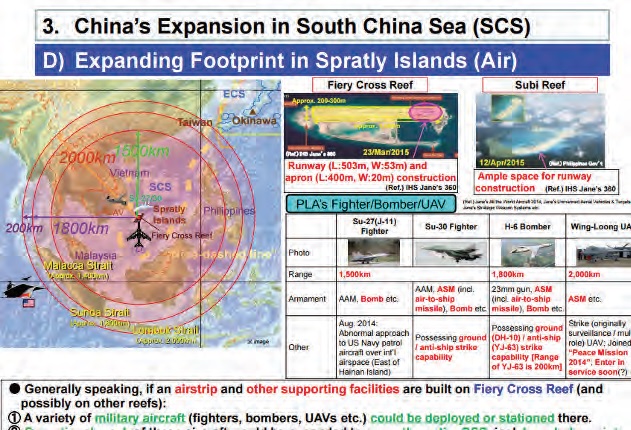
When the court took jurisdiction over the case filed by the Philippines, which has its own territorial claims in the region, China brushed it off as a “futile” attack on its sovereignty which would “lead to nothing.”
Legal experts now say Manila has a good chance of success based on the court’s rejection of China’s arguments during the hearing on jurisdiction. Such a scenario would mark the first time an international court has intervened in the matter – something Beijing has been trying to avoid for years.
International energy lawyers and officials from other countries in the region are keeping their eyes on the case. Vietnam, Malaysia, Brunei and Taiwan also claim parts of the South China Sea, which serves as a waterway through which $5 trillion worth of ship-borne trade passes through each year.
“Other countries will use it as a stick to beat Beijing with,” said Ian Storey, a South China Sea expert at Singapore’s Institute of South East Asian Studies, in an interview with Reuters. “That’s why China is so freaked by this whole issue.”
Manilla filed the case in hopes of earning a court’s ruling on its right to exploit waters in its 200-nautical mile exclusive economic zone as allowed under the United Nations Convention on the Law of the Sea (UNCLOS). This treaty defines territorial and economic zones based on factors such as islands, rocks and reefs China, which claims most of the South China Sea, has been expanding its efforts in building artificial islands in the region. Even though it ratified UNCLOS, Beijing dismisses the court’s authority and claims it will deny any ruling – a claim reiterated by China’s Foreign Ministry on Tuesday.
Such a response is likely as no entity would enforce a legally-binding ruling in support of the Philippines. Still, China would face pressure on the world stage, especially at regional meetings.”
